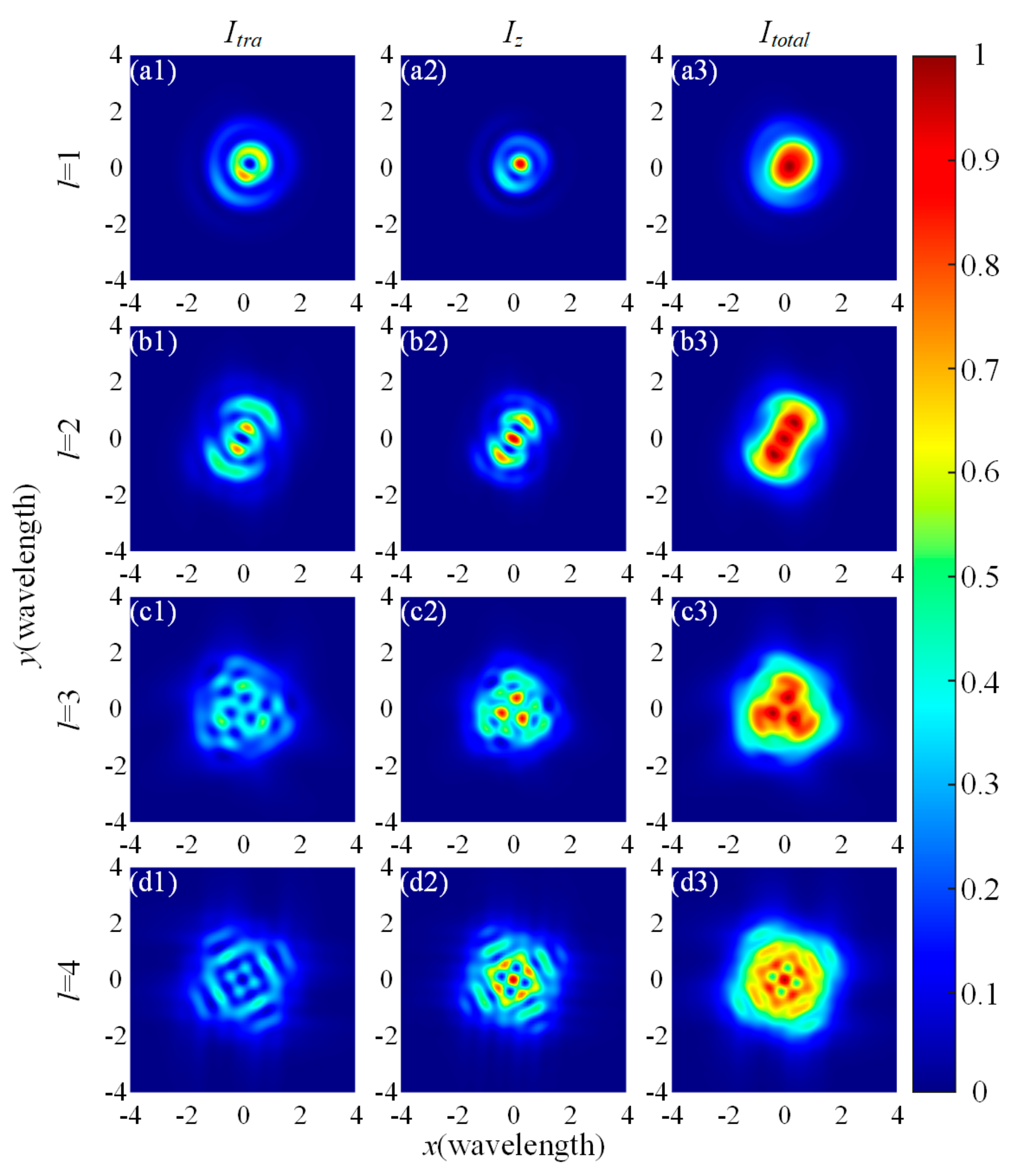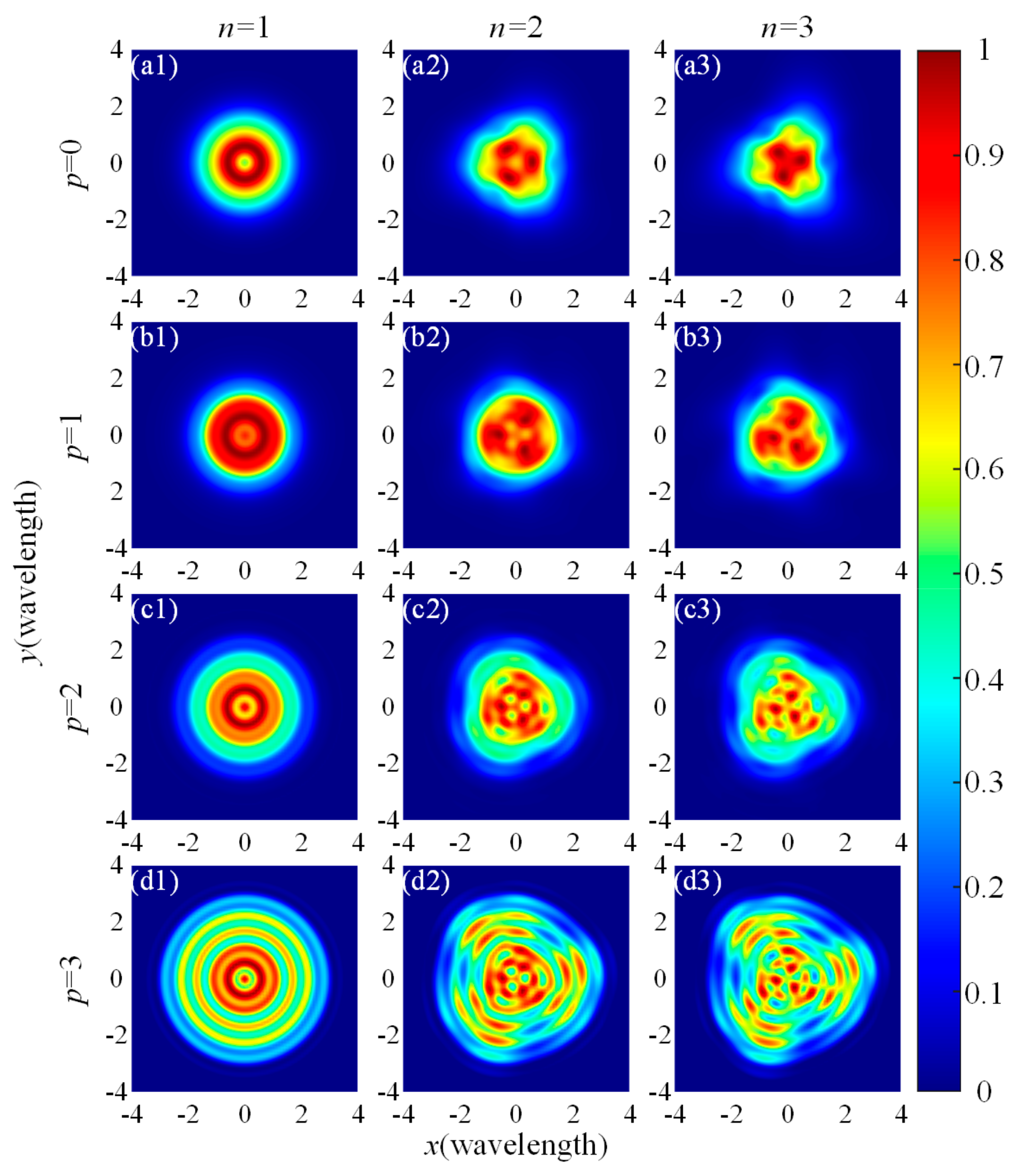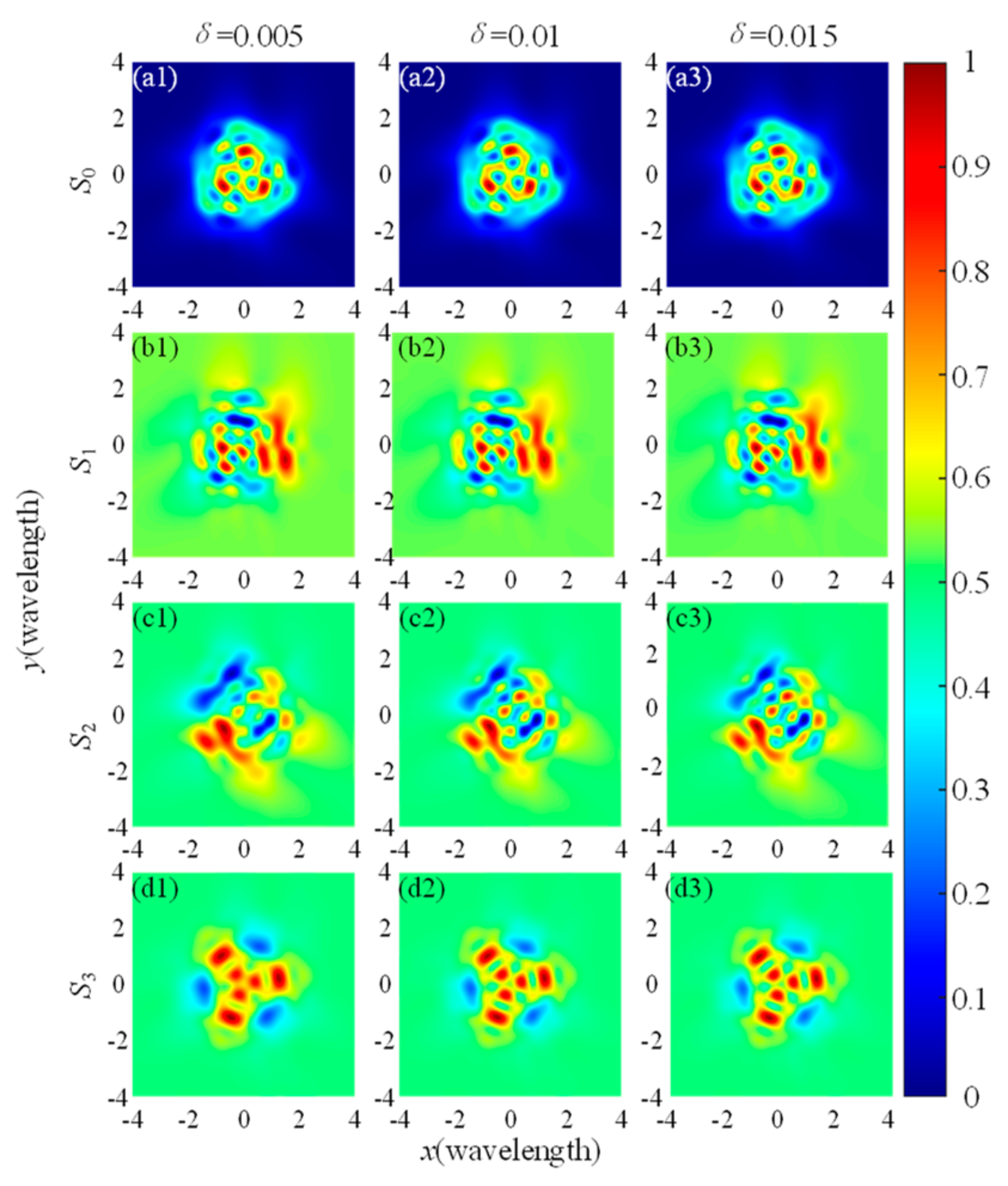Statistical Properties of Partially Coherent Higher-Order Laguerre-Gaussian Power-Exponent Phase Vortex Beams
Abstract
1. Introduction
2. Theory
2.1. Theory for RP-LG-RSPEPV Beams with LGSM
2.2. Theory for the Tight-Focusing of RP-LG-RSPEPV Beams with LGSM
3. Results and Discussions
3.1. The Relationships between Tight-Focusing Properties and Topological Charges, the Power Exponent and Radial Index
3.2. The Relationships between Tight-Focusing Properties and the Spatial Correlation Length, and the Order of LGSM
3.3. Degree of Polarization and Degree of Coherence of Tightly Focused RP-LG-RSPEPV Beams in the Transverse Direction
4. Conclusions
Author Contributions
Funding
Institutional Review Board Statement
Informed Consent Statement
Data Availability Statement
Conflicts of Interest
References
- Ma, Z.Y.; Chen, K.; Zhang, M.M.; Dou, J.T.; Hu, Y.Y. Propagation characteristics of Laguerre-Gaussian power-exponentphase-vortex beams. Acta. Opt. Sin. 2022, 42, 0526001. [Google Scholar] [CrossRef]
- Chen, K.; Ma, Z.Y.; Zhang, M.M.; Dou, J.T.; Hu, Y.Y. The tight-focusing properties of radially polarized symmetrical power-exponent-phase vortex beam. J. Opt. 2022, 24, 055602. [Google Scholar] [CrossRef]
- Chen, K.; Ma, Z.Y.; Zhang, M.M.; Dou, J.T.; Hu, Y.Y. Propagation properties of partially coherent power-exponent-phase vortex beam. Acta. Phys. Sin. 2022, 71, 014203. [Google Scholar] [CrossRef]
- Chen, K.; Ma, Z.Y.; Hu, Y.Y. Tightly focused properties of a partially coherent radially polarized power-exponent-phase vortex beam. Chin. Phys. B 2023, 32, 024208. [Google Scholar] [CrossRef]
- Lao, G.M.; Zhang, Z.H.; Zhao, D.M. Propagation of the power-exponent-phase vortex beam in paraxial ABCD system. Opt. Express 2016, 24, 18082–18094. [Google Scholar] [CrossRef] [PubMed]
- Pan, Y.Q.; Zhao, M.L.; Zhang, M.M.; Dou, J.T.; Zhao, J.; Li, B.; Hu, Y.Y. Propagation properties of rotationally-symmetric power-exponent-phase vortex beams through oceanic turbulence. Opt. Laser Technol. 2023, 159, 109024. [Google Scholar] [CrossRef]
- Pei, Z.H.; Huang, S.J.; Chen, Y.; Yan, C. Comparison of microparticle manipulating characteristics of canonical vortex beam and power-exponent-phase vortex beam. J. Mod. Opt. 2021, 68, 224–232. [Google Scholar] [CrossRef]
- Shen, D.H.; Wang, K.; Zhao, D.M. Generation and propagation of a new kind of power-exponent-phase vortex beam. Opt. Express 2019, 27, 24642–24653. [Google Scholar] [CrossRef]
- Hu, Y.Y.; Zhang, M.; Dou, J.T.; Zhao, J.; Li, B. Influences of salinity and temperature on propagation of radially polarized rotationally-symmetric power-exponent-phase vortex beams in oceanic turbulence. Opt. Express 2022, 30, 42772–42783. [Google Scholar] [CrossRef]
- Wu, Z.H.; Zhao, J.; Dou, J.T.; Liu, J.; Jing, Q.L.; Li, B.; Hu, Y.Y. Optical trapping of multiple particles based on rotationally-symmetric power-exponent-phase vortex beams. Opt. Express 2022, 30, 42892–42901. [Google Scholar] [CrossRef]
- Yan, X.; Guo, L.X.; Cheng, M.J.; Li, J.; Huang, Q.; Sun, R. Probability density of orbital angular momentum mode of autofocusing Airy beam carrying power-exponent-phase vortex through weak anisotropic atmosphere turbulence. Opt. Express 2017, 25, 15286–15298. [Google Scholar] [CrossRef] [PubMed]
- Ma, Z.Y.; Zhao, W.Q.; Zhao, J.; Liu, J.; Jing, Q.; Dou, J.T.; Li, B.; Hu, Y.Y. Generation of arbitrary higher-order Poincaré sphere beams from a ring fiber laser with cascaded Q-plates. Opt. Laser Technol. 2022, 156, 108552. [Google Scholar] [CrossRef]
- Hu, Y.Y.; Ma, Z.Y.; Zhao, W.Q.; Zhao, J.; Liu, J.; Jing, Q.L.; Dou, J.T.; Li, B. Controlled generation of mode-switchable nanosecond pulsed vector vortex beams from a Q-switched fiber laser. Opt. Express 2022, 30, 33195–33207. [Google Scholar] [CrossRef] [PubMed]
- Miao, D.; Zhao, C.L.; Cai, Y.J.; Yang, Y. Partially coherent vortex beams: Fundamentals and applications. Sci. China Phys. Mech. Astron. 2021, 64, 224201. [Google Scholar] [CrossRef]
- Ping, C.C.; Liang, C.H.; Wang, F.; Cai, Y.J. Radially polarized multi-Gaussian Schell-model beam and its tight focusing properties. Opt. Express 2017, 25, 32475–32490. [Google Scholar] [CrossRef]
- Xu, H.F.; Zhang, R.; Sheng, Z.Q.; Qu, J. Focus shaping of partially coherent radially polarized vortex beam with tunable topological charge. Opt. Express 2019, 27, 23959–23969. [Google Scholar] [CrossRef]
- Fan, C.J.; Liu, Y.X.; Wang, X.Y.; Chen, Z.; Pu, J. Trapping two types of particles by using a tightly focused radially polarized power-exponent-phase vortex beam. J. Opt. Soc. Am. A 2018, 35, 903–907. [Google Scholar] [CrossRef]
- Man, Z.S.; Min, C.J.; Du, L.P.; Zhang, Y.; Zhu, S.; Yuan, X. Sub-wavelength sized transversely polarized optical needle with exceptionally suppressed side-lobes. Opt. Express 2016, 24, 874–882. [Google Scholar] [CrossRef] [PubMed]
- Chen, J.; Wan, C.H.; Kong, L.J.; Zhan, Q. Experimental generation of complex optical fields for diffraction limited optical focus with purely transverse spin angular momentum. Opt. Express 2017, 25, 8966–8974. [Google Scholar] [CrossRef]
- Chang, D.; Vuletić, V.; Lukin, M. Quantum nonlinear optics-photon by photon. Nat. Photon. 2014, 8, 685–694. [Google Scholar] [CrossRef]
- Miao, D.; Jiang, D.G.; Luo, N.H.; Yang, Y. Trapping two types of Rayleigh particles using a focused partially coherent anomalous vortex beam. Appl. Phys. B 2019, 125, 55. [Google Scholar] [CrossRef]
- Zhao, C.L.; Cai, Y.J.; Lu, X.H.; Eyyuboğlu, H.T. Radiation force of coherent and partially coherent flat-topped beams on a Rayleigh particle. Opt. Express 2009, 17, 1753–1765. [Google Scholar] [CrossRef] [PubMed]
- Cheng, W.; Haus, J.W.; Zhan, Q.W. Propagation of vector vortex beams through a turbulent atmosphere. Opt. Express 2009, 17, 17829–17836. [Google Scholar] [CrossRef] [PubMed]
- Kozawa, Y.; Matsunaga, D.; Sato, S. Superresolution imaging via superoscillation focusing of a radially polarized beam. Optica 2018, 5, 86–92. [Google Scholar] [CrossRef]
- Chen, K.; Li, S.Z.; Pan, Y.Q.; Zhang, M.; Yang, Y.Q.; Hu, Y.Y. Tight Focusing Properties of Partially Coherent Radially Polarized Rotationally-Symmetric Power-Exponent-Phase Vortex Beam. Acta. Opt. Sin. 2022, 42, 2226002. [Google Scholar] [CrossRef]
- Eyyuboğlu, H.T. Partially coherent Lorentz Gaussian beam and its scintillations. Appl. Phys. B 2011, 103, 755–762. [Google Scholar] [CrossRef]
- Zhu, K.C.; Zhou, G.Q.; Li, X.G.; Zheng, X.; Tang, H. Propagation of Bessel-Gaussian beams with optical vortices in turbulent atmosphere. Opt. Express 2008, 16, 21315–21320. [Google Scholar] [CrossRef]
- Chen, Y.H.; Wang, F.; Zhao, C.L.; Cai, Y.J. Experimental demonstration of a Laguerre-Gaussian correlated Schell-model vortex beam. Opt. Express 2014, 22, 5826–5838. [Google Scholar] [CrossRef]
- Khan, S.N.; Stuti, J.S.; Kanseri, B.; Senthilkumaran, P. Detection of partially coherent polarization singular vector beams using Stokes polarimetry. Appl. Phys. Lett. 2021, 118, 051104. [Google Scholar] [CrossRef]
- Bomzon, Z. Angular momentum and geometrical phases in tight-focused circularly polarized plane waves. Appl. Phys. Lett. 2006, 118, 051104. [Google Scholar] [CrossRef]









Disclaimer/Publisher’s Note: The statements, opinions and data contained in all publications are solely those of the individual author(s) and contributor(s) and not of MDPI and/or the editor(s). MDPI and/or the editor(s) disclaim responsibility for any injury to people or property resulting from any ideas, methods, instructions or products referred to in the content. |
© 2023 by the authors. Licensee MDPI, Basel, Switzerland. This article is an open access article distributed under the terms and conditions of the Creative Commons Attribution (CC BY) license (https://creativecommons.org/licenses/by/4.0/).
Share and Cite
Ma, Z.; Pan, Y.; Dou, J.; Zhao, J.; Li, B.; Hu, Y. Statistical Properties of Partially Coherent Higher-Order Laguerre-Gaussian Power-Exponent Phase Vortex Beams. Photonics 2023, 10, 461. https://doi.org/10.3390/photonics10040461
Ma Z, Pan Y, Dou J, Zhao J, Li B, Hu Y. Statistical Properties of Partially Coherent Higher-Order Laguerre-Gaussian Power-Exponent Phase Vortex Beams. Photonics. 2023; 10(4):461. https://doi.org/10.3390/photonics10040461
Chicago/Turabian StyleMa, Zhiyuan, Yuqi Pan, Jiantai Dou, Jiang Zhao, Bo Li, and Youyou Hu. 2023. "Statistical Properties of Partially Coherent Higher-Order Laguerre-Gaussian Power-Exponent Phase Vortex Beams" Photonics 10, no. 4: 461. https://doi.org/10.3390/photonics10040461
APA StyleMa, Z., Pan, Y., Dou, J., Zhao, J., Li, B., & Hu, Y. (2023). Statistical Properties of Partially Coherent Higher-Order Laguerre-Gaussian Power-Exponent Phase Vortex Beams. Photonics, 10(4), 461. https://doi.org/10.3390/photonics10040461




